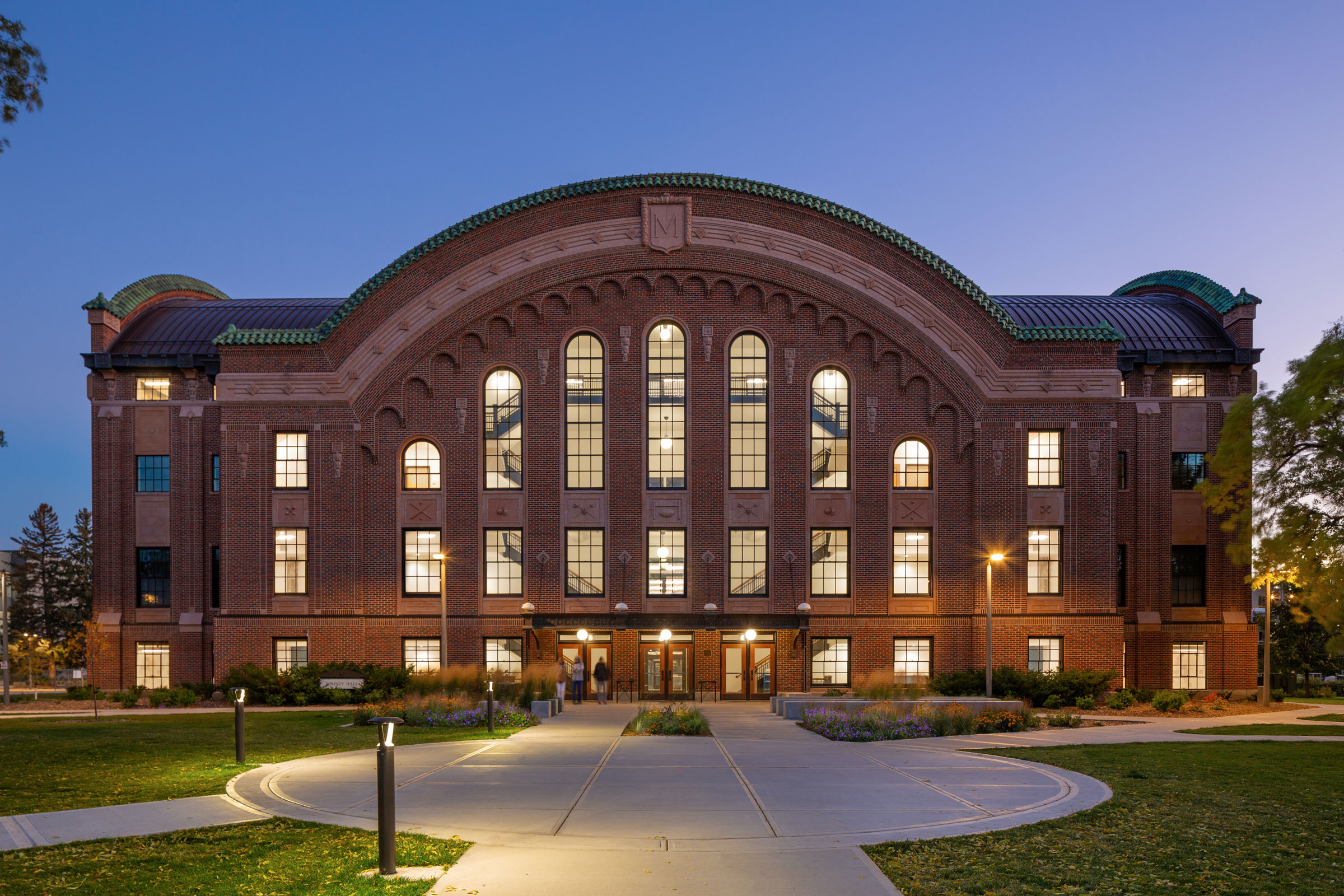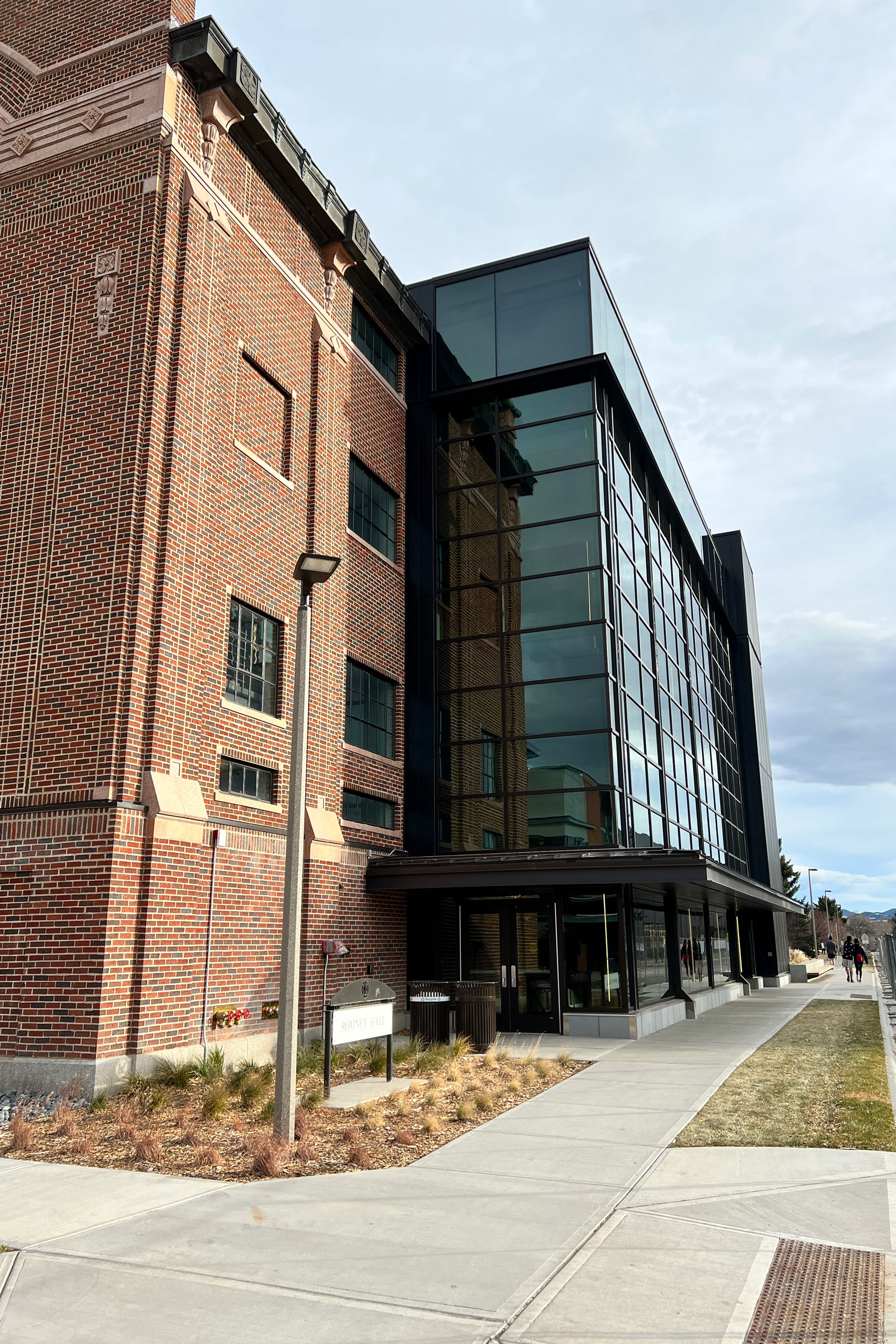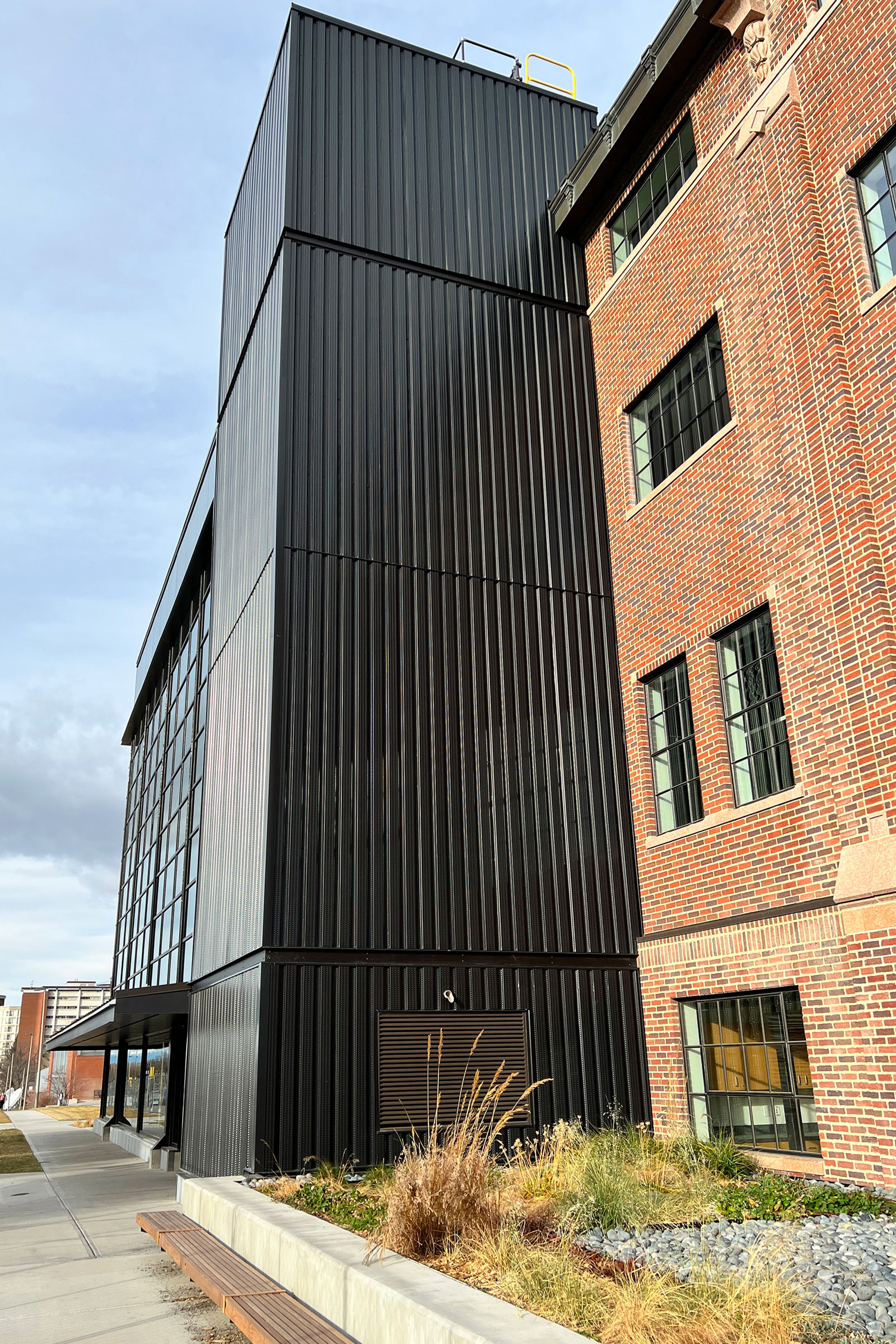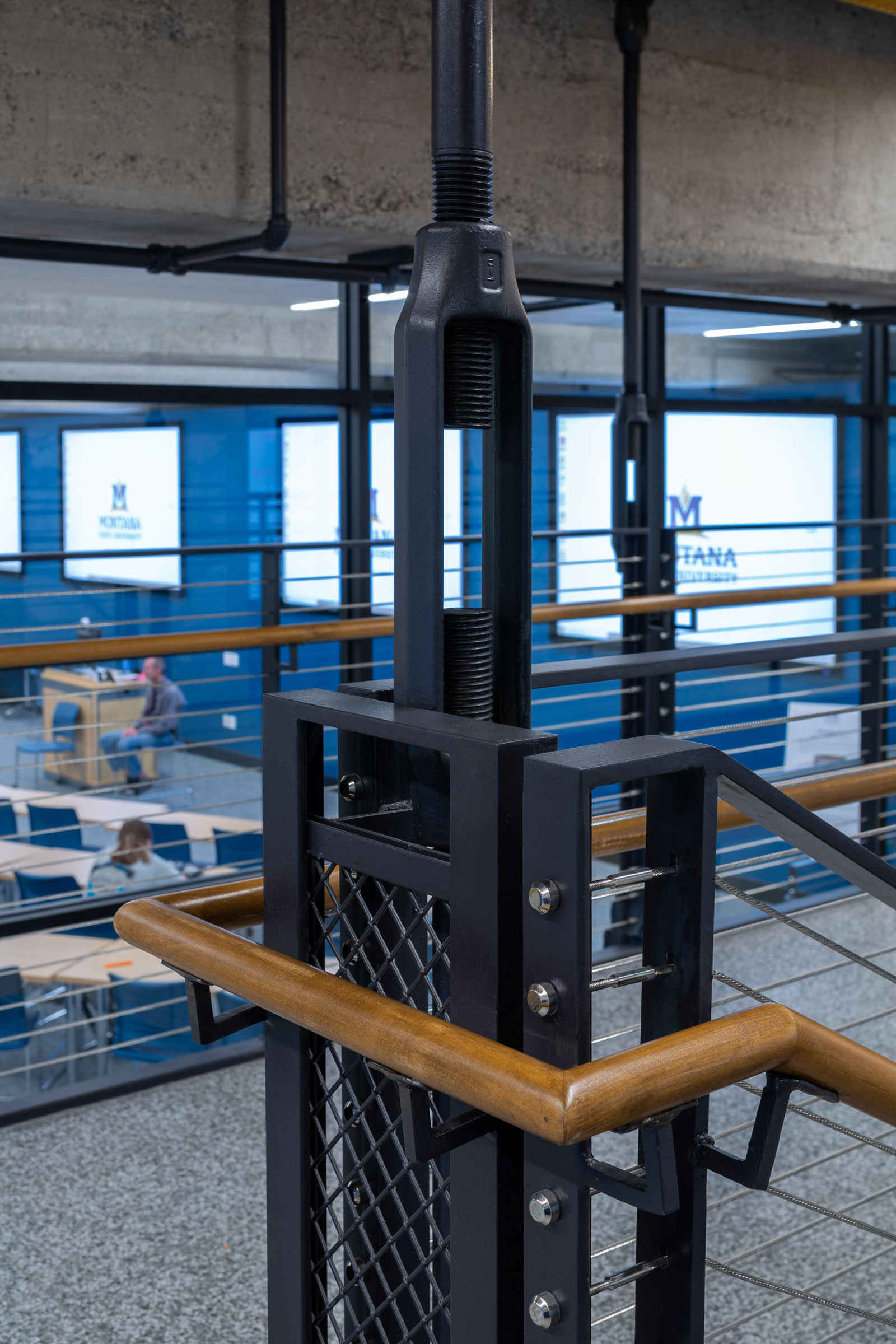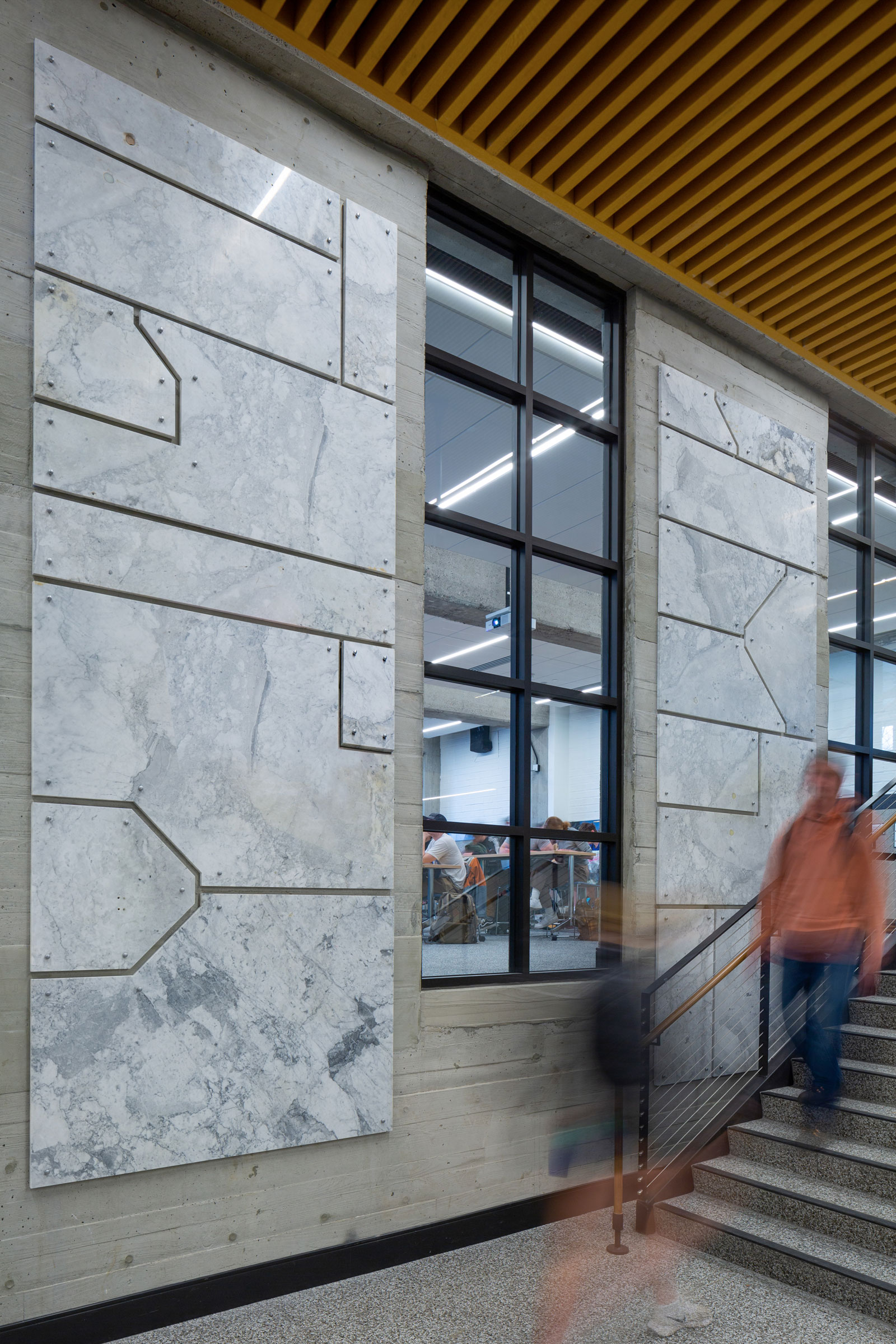Story at a glance:
- Cushing Terrell combines historical preservation and environmental stewardship in the Montana State University Romney Hall renovation.
- The LEED Gold project transformed a space from 141 classroom seats to a building with 1,010 seats.
- Post renovation, Romney Hall is one of the most utilized buildings on campus.
There’s a thoughtful balance to maintain when modernizing historic buildings. We must honor the past, a building’s architectural style, its prior uses, and the stories of the people who’ve passed through its doors and experienced life within its walls. Then there’s the need to optimize the space and repurpose it for contemporary uses and the experiences and stories of new generations.
With the renovation of Montana State University’s (MSU) Romney Hall—a beloved, century-old icon on the university’s campus in Bozeman—we brought all the talents of our multidisciplinary team at Cushing Terrell to the task, including many people who themselves spent formative years at MSU.
A Little History

Photo by Karl Neumann
Our big priorities for the project were to make the building fully accessible, incorporate life-safety upgrades, optimize energy efficiency, apply sustainable design principals, maintain elements of the building’s Italian Renaissance Revival style, ensure a connection to history, and add at least 1,000 classroom seats.
Romney Hall was built in 1921 and 1922 as a physical education building. Named after George Ottinger “Ott” Romney, MSU’s head football and basketball coach from 1922 to 1927, the building comprised handball courts, a running track, a swimming pool, and a gymnasium that could seat up to 3,000 spectators.
In the 1960s and ’70s the university built new athletic facilities and Romney was no longer a hub for activity. With most of the space in the 54,000-square-foot building unusable for teaching and learning, it had become obsolete in terms of present-day functionality but was ripe for reinvention.
As the largest and fastest-growing university in Montana, MSU knew it needed to renovate Romney Hall to fully utilize its square footage and add much-needed classroom space; however, there was a major hurdle to overcome.
Making Up for Lost Time
One of the challenges we faced with this project was the time it took for the Montana State Legislature to approve funding. We waited through four legislative sessions, each time anticipating the need to reconvene the design team. We interviewed for the project in 2012, began programming and schematic design in 2015, picked up design development in 2017, and completed construction drawings in 2019 when funding for the project was finally passed.
During this lengthy timeframe team members became engaged on other projects, became available again, and then took on new projects. Our ability to ramp up when the good news came was made possible by having all our design disciplines “under one roof” and the strength and cohesion of our teams. When looking back on the number of team members who contributed at some point to this decade-long project, it’s quite extensive.
Demolition & Design
- A new stair/elevator core addition on the south side of the building makes all floors of the building accessible. Photo by Karl Neumann
- The enclosure consists primarily of aluminum curtain wall, which provides a high degree of transparency to reveal the historic brick wall. The elevator shaft is clad in dark-colored perforated metal panel to capture solar-heated air, which is incorporated into the building’s HVAC system using SolarWall technology. Photo by Karl Neumann
Turning a 100-year-old athletics building—with a large gymnasium and pool—into functional classroom space was not a task for the faint of heart. This beautiful, old building was complicated because of what it was originally built to accommodate. Having completed an upfront historic preservation and structural analysis of the building prior to being awarded the renovation contract helped our team prepare and plan for what we’d encounter.
With the timing of the funding the project had an early demolition package, thus we were designing while the building was demoed. This was quite beneficial, as the insights gained during this process helped inform our design decisions, including what we could reuse. More than half of Romney’s building resources were preserved and reused, including structural elements, enclosure materials, and permanently installed interior elements. More than 2,300 tons of construction waste were recycled and/or reused—ultimately diverted from the landfill.
As the design intent was to leave existing finishes exposed wherever possible, we used knowledge gained from the demolition to verify which areas were acceptable as they were and which needed additional treatment. We were also able to locate the mechanical/pipe chases that existed throughout the building and determine if they could be reused and coordinate pipe routing for new radiators.
During demolition we discovered each floor was a different height (to accommodate the athletic functions) with clay-tile interior partition walls where the poured concrete floor elevations varied from one side of the wall to the other. Thus the design called for stair landings to be adjusted, floors to be ground down with infill added, and sloped floor transitions to be incorporated to tie everything together as seamlessly as possible.
To overcome access issues caused by the varying floor levels, the interior circulation areas were completely removed, except for the north stair hall, which was retained as a character-defining feature. The narrow corridors, south stairs, and pool were all replaced with a new grade-level entry corridor that leads to the Veterans Support Center and Office of Disability Services.
To extend the life of the building for many generations, give all students access to all floors, and maximize classroom space, the Romney Hall renovation involved extensive structural alterations. Floor space added inside the historic structure placed new loads on the existing structural elements and required the strengthening of the foundation components, which also included seismic upgrades.
Accessible & Energy-Efficient
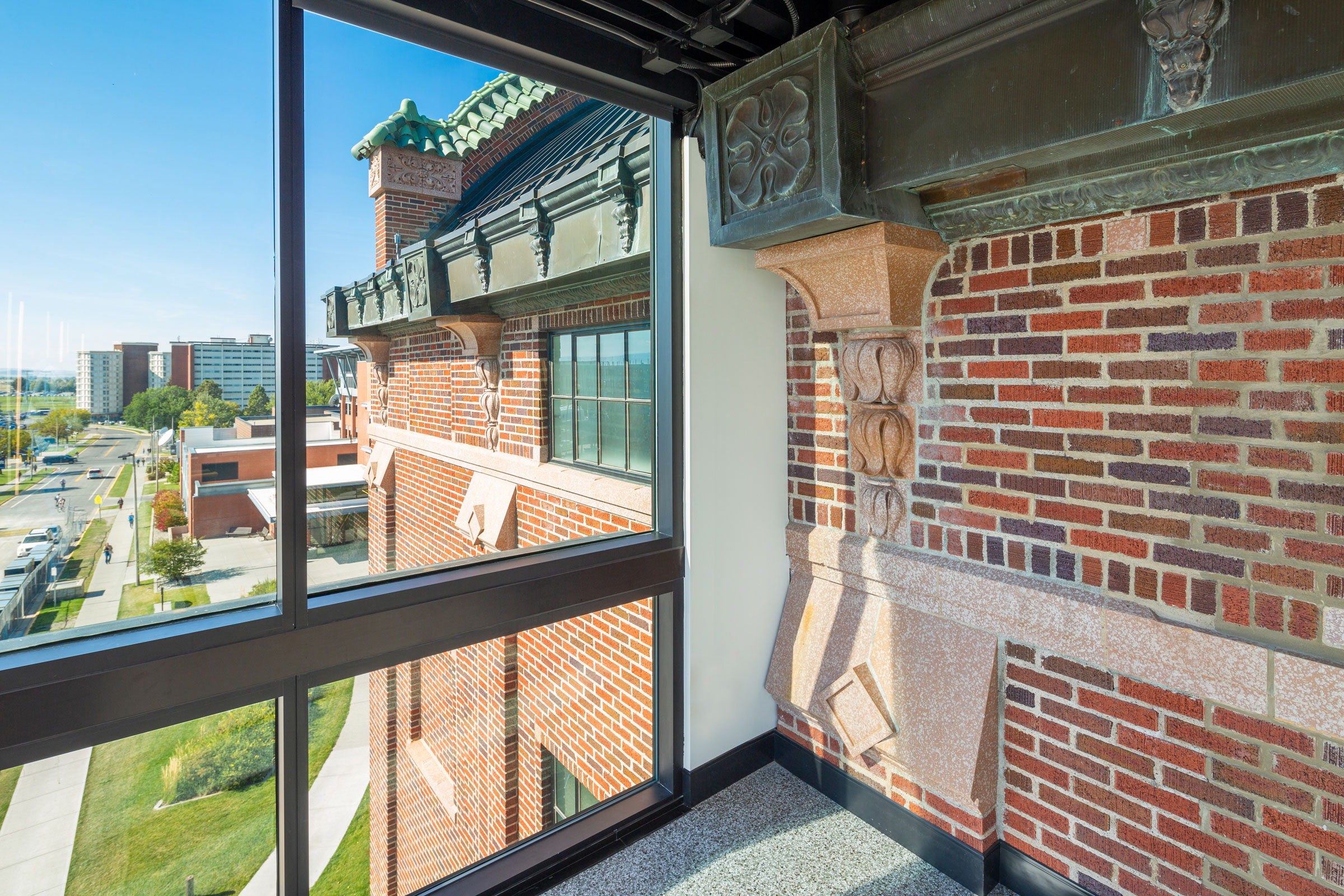
Photo by Karl Neumann
Creating accessibility for all and achieving optimal energy performance were two of the primary goals for the project. Because of the complexity of the interior spaces and the need to fully utilize those spaces as learning environments, our design team collaborated with the State Historic Preservation Office to come up with a sensitive solution to achieve the desired results.
The solution was to replace the existing stair tower on the south side of the building with a new stair/elevator core addition. The enclosure is made of aluminum curtain wall, which provides a high degree of transparency to reveal the historic brick wall while the elevator shaft is clad in dark-colored perforated metal panel, which captures solar-heated air. Using SolarWall technology this heated air is incorporated into the building’s HVAC system to reduce energy consumption and heating costs.
The building also benefits from a high-efficiency geothermal-energy system under the Romney Oval—an open space situated north of Romney Hall. The geothermal system will serve other nearby buildings as part of MSU’s campus-wide energy master plan being developed by Cushing Terrell’s Energy Services team and will be one of several energy districts on campus.
The SolarWall technology, HVAC system upgrades, building enclosure upgrades, and new, replica steel windows all contribute to improving the building’s energy performance by 40.9% compared with a baseline building designed to meet minimum code requirements.
Aligning with the Secretary of the Interior’s Standards for the Rehabilitation of Historic Buildings, the new stair/elevator addition differentiates from the historic structure while ensuring historic materials and features are still seen and celebrated. The addition also serves as a teaching tool, along with the other systems and solutions implemented at Romney Hall. Educational tours for architectural and engineering students and other interested groups have been a regular part of the project, and they continue today.
Carving Out More Space
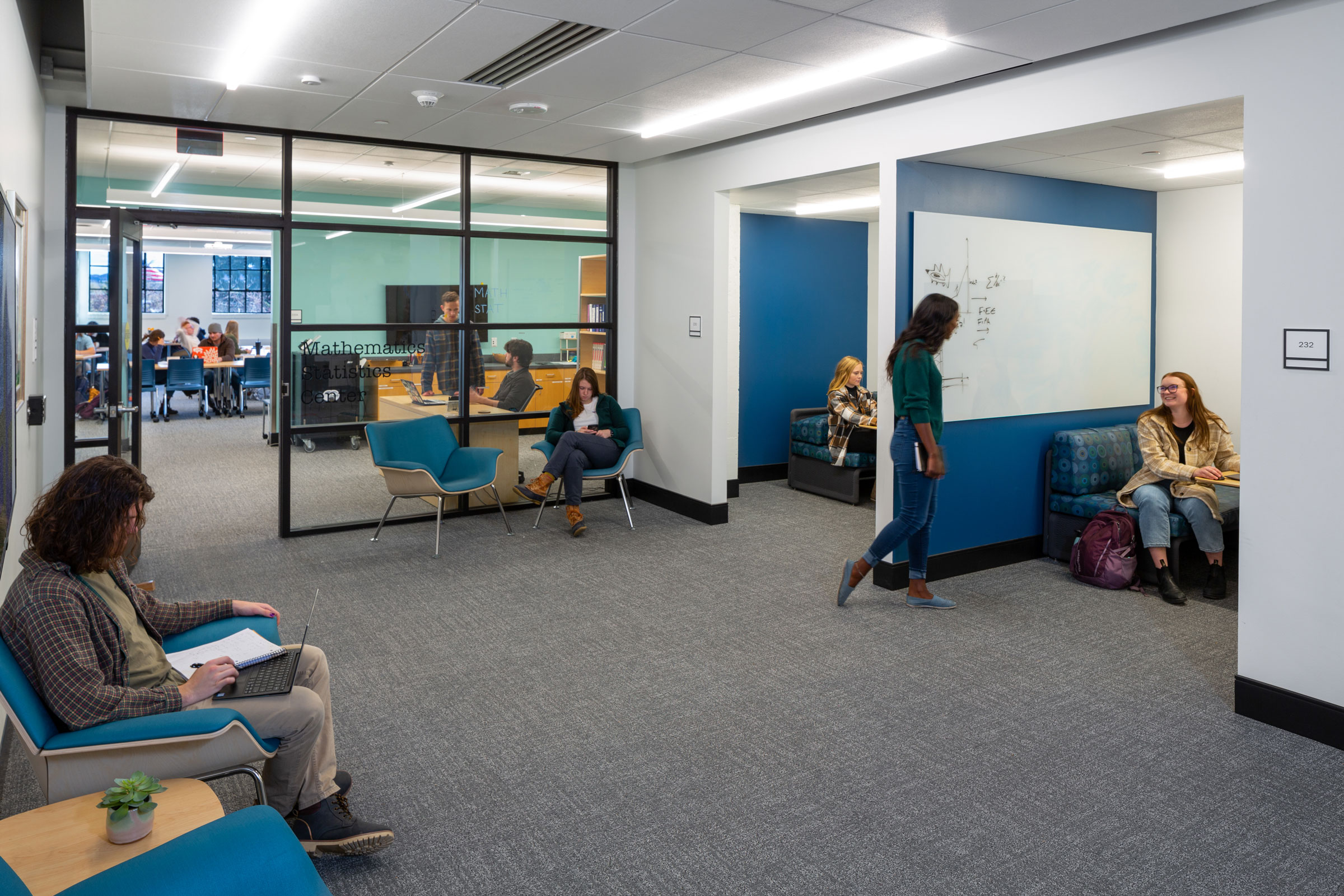
A variety of different-sized classrooms, collaboration, and study areas were designed throughout the building. The Mathematics and Statistic Center includes breakout spaces outside the center. Photo by Karl Neumann

Photo by Karl Neumann
The renovation and repurposing of Romney Hall not only preserved a state historic treasure but also provided much-needed upgrades to accommodate the expansion of student services and meet educational and accessibility needs.
The result was the creation of 17 new classrooms, student-focused collaboration and study areas, and space for high-impact programs like the Travis W. Atkins Veteran Support Center, the Office of Disability Services, the Writing Center, and the Dr. Christopher B. Lofgren Center for Excellence in Mathematics and Statistics Center.
Accessible restrooms, family care facilities, and single-use toilet rooms are now available on each level, and the building is comfortable and efficient with new mechanical, electrical, and fire suppression systems.
Additional breakout spaces and study areas along a stairway/hall corridor to optimize the space. Post renovation, Romney Hall is one of the most utilized buildings on campus.
Overall Romney Hall was transformed from a building with 141 classroom seats to a building with 1,010 seats. Where did all the new classroom space come from?
New floors were inserted above existing spaces on the third floor to provide approximately 13,000 square feet of additional area for classrooms and student study space. New, usable space was also created at what is called “level zero” through selective excavation that lowered the floor to provide the required headroom in new 100-seat classrooms.
Additionally our team was able to meet the 1,000-plus-seat goal by designing various classroom types that range from 24-seat instructional rooms to a 300-person lecture hall, or “classroom in the round,” that showcases a section of the former gym floor.
Preserving History
- Photo by Karl Neumann
- Photo by Karl Neumann
One of the things we took great joy in was repurposing the historic materials and features for other things.
For example, marble wall panels were used as decorative elements, now displayed along the staircase, and were even repurposed as shower stalls.
The original terrazzo floors in the north stair were cleaned and restored while complimentary terrazzo tile was installed in high-traffic areas.
The original gymnasium balcony suspension rods and hardware at level four were left exposed, serving as a memory of past athletic events, and inspiring the detailed metal components for the new grade-level walkway, stairs, guardrails, and other interior elements.
Design for the Future
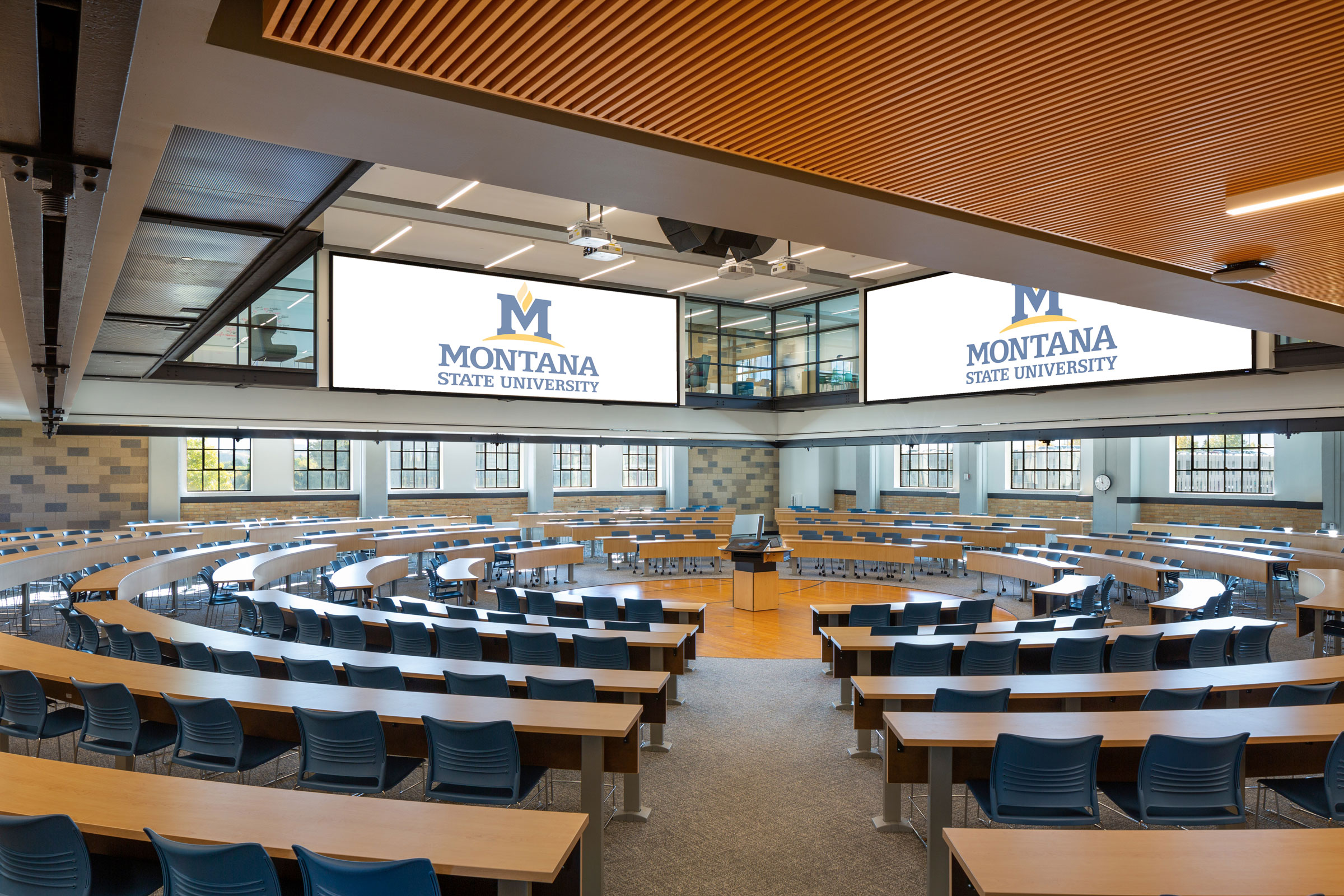
Glimpses of the past, like the gym floor, align with the goal of honoring Romney Hall’s history and celebrating the building’s evolution. Photo by Karl Neumann
Romney Hall is also well-positioned for the future, not only in terms of the classroom space and student services it provides but also as a cornerstone of MSU’s campus energy district development. Romney Hall and the geothermal field under Romney Oval will connect to future buildings on the Grant Street corridor. This energy district will further reduce campus carbon emissions and provide opportunities for buildings on campus to share energy.
Like other great universities, MSU’s forward-thinking commitments ensure its actions benefit the students of today and tomorrow. This means being a good caretaker of the past and the future, providing best-in-class student services and learning environments, and building on MSU’s legacy.
Sustainable Design Achievements
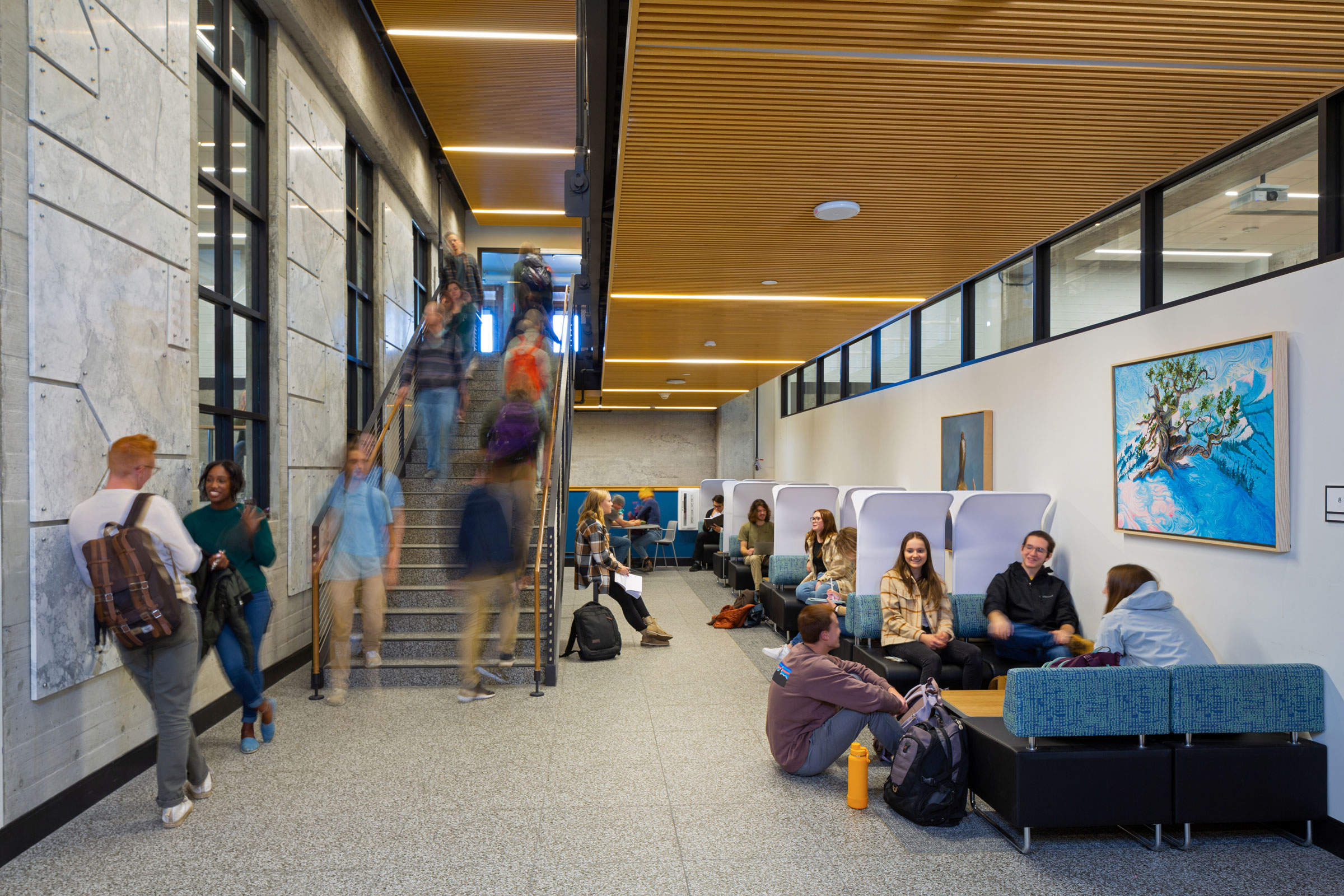
Additional breakout spaces and study areas along a stairway/hall corridor optimize the space at MSU’s Romney Hall. Photo by Karl Neumann
While there’s much to celebrate about Romney Hall, these are the project’s most notable sustainability achievements:
Campus-wide Commitment. The ninth LEED building on the MSU campus, Romney Hall achieved LEED Gold and further demonstrates the university’s commitment to sustainability.
Building and Material Reuse. Nearly 55% of Romney Hall’s existing building resources were preserved and reused including structural elements, enclosure materials, and interior elements.
Energy Performance Optimizations. Guided by computer-based energy modeling simulations, the renovation improved the building’s energy performance by 40.9% compared to a building designed to meet minimum code requirements.
Commissioning. To verify that the project’s energy-related systems were installed, calibrated, and performed according to MSU’s high-performance building standards, the mechanical, electrical, hot water, and geothermal systems underwent a systematic quality-focused commissioning process.
Water Use Reduction. Through the installation of water-efficient fixtures, Romney Hall is expected to achieve a 33% indoor water use reduction compared to a baseline building designed without water efficient fixtures.
Outdoor Air Delivery Monitoring. Permanent carbon dioxide monitoring systems were installed to track CO2 levels while allowing MSU facilities teams to ensure adequate outdoor air ventilation rates are maintained.
Acoustic Performance. To promote acoustic comfort and provide learning environments that facilitate effective communications and occupant well-being, the design includes materials and features to limit background noise and the transmission of noise between spaces.
Controllable Lighting Systems. Throughout the building newly installed controls provide a high level of lighting-system control, helping enhance productivity, comfort, and well-being.
Low-Emitting Materials. To promote a healthy indoor environment, the following measures were achieved: 100% of paints, coatings, adhesives, and sealants used on the interior of the building met the standards for low-emitting materials; 100% of installed flooring-system products met the testing and product requirements for low-emitting flooring materials; and 100% of composite wood/agrifiber products used on the interior of the building do not contain added urea-formaldehyde resins.
Recycled Content. More than 25% of the total materials budget was invested in products with environmentally and socially preferable life cycle impacts, including sustainable forestry practices, products containing pre- and post-consumer recycled content, and products purchased from manufacturers who participate in take-back recycling programs that minimize material waste.
Environmental Product Declarations. Forty-two products with EPDs were installed. This earned Romney Hall an exemplary performance status for the sourcing of products and materials from manufacturers who have verified improved environmental life cycle impacts of their products.
Material Ingredients. Thirty-eight products with transparent disclosure of material ingredients were installed. This achievement exceeded the baseline requirement of 20 products and helps promote products and materials that evaluate and disclose human and environmental health impacts.
Construction Indoor Air Quality Management Plan. During construction an indoor air quality management plan was enforced to protect HVAC equipment, absorptive materials, and prioritize regular maintenance of the building to reduce indoor air contaminants.
Construction Waste Management. Throughout construction a total of 2,319 tons or 78.28% of all construction waste were recycled and/or reused and ultimately diverted from the landfill.
Project Details
Project: Romney Hall, Montana State University
Location: Bozeman, MT
Completion: 2022
Size: 54,000 square feet
Architects: Cushing Terrell, SRG Partnership
Contractor: Swank Enterprises
Engineer: Cushing Terrell
Interior Design, Lighting & Landscape: Cushing Terrell
Energy Modeling & Envelope: Cushing Terrell
Theatrical/AV: TEECOM
Acoustical Engineer: Big Sky Acoustics
Geothermal Consultant: Major Geotherma
Awards: LEED Gold

